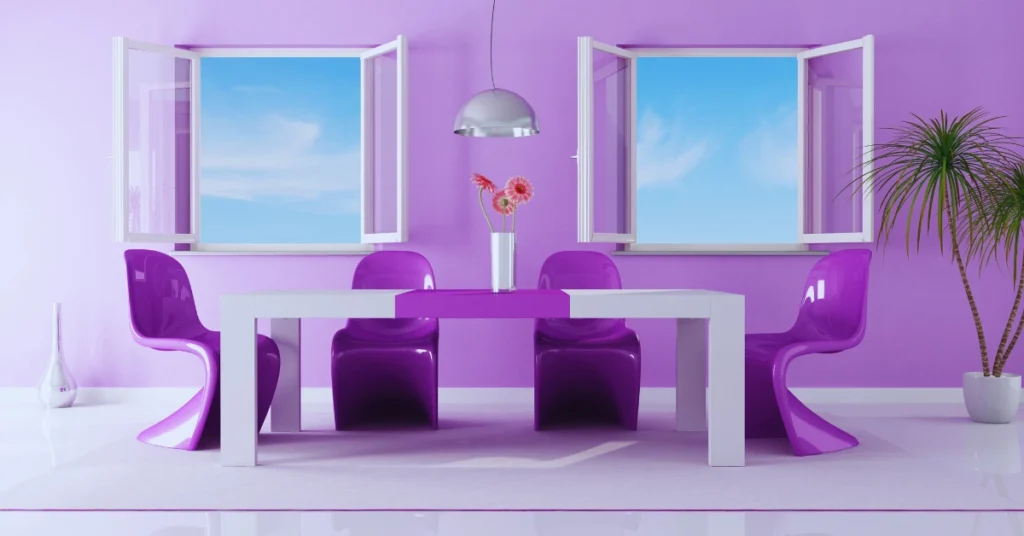You walk into a room bathed entirely in purple. The walls, ceiling, and even the furniture are shades of this vibrant color. At first, the deep hues might feel intriguing, even mysterious. You may notice your mood shifting subtly as you begin to process the unique atmosphere.
In this immersive space, your emotions and mental state start to evolve—calmness blends with curiosity, and creativity starts to stir. But could spending an extended period in such an environment bring about more profound psychological effects? Let’s dive into the fascinating impacts of a purple room on the human mind and body.
Table of Contents
ToggleThe Psychological Effect of Purple: Understanding the Basics
Purple is a color with a rich history of symbolism. Associated with royalty, spirituality, and creativity, it holds a unique position in the spectrum of colors. Psychologically, it combines the stability of blue with the energy of red, creating an intriguing balance that can influence human emotions and thought processes in different ways.
How Purple Affects the Mind:
Calming and Soothing: Similar to blue, purple can induce a sense of calmness, especially lighter shades like lavender or lilac.
Stimulating Creativity: Purple is often linked to imagination and inspiration, making it a favorite among artists and thinkers.
Promoting Spiritual Reflection: Its connection to mysticism and spirituality encourages introspection and meditation.
Potential Overstimulation: Deep, intense shades of purple may feel overwhelming over time, potentially leading to discomfort or mental fatigue.
The Immediate Response to a Purple Room
Upon entering a purple room, the first reaction is often curiosity. The unusual choice of color naturally catches attention, drawing the eye to details and creating a sense of wonder.
Short-Term Reactions:
Heightened Awareness: Purple rooms often feel unconventional, making the environment seem more stimulating and engaging.
Relaxation or Calmness: If the purple is soft and muted, it can immediately set a tranquil tone, helping to reduce stress.
Boosted Creativity: The vibrant color can spark imaginative thinking, especially for tasks involving brainstorming or problem-solving.
In scenarios where individuals are asked to spend only a short time in a purple room, these effects are typically positive and enjoyable.

Extended Time in a Purple Room: What Happens?
When someone spends a longer duration in a purple room, the psychological and emotional effects can deepen. Let’s break this down further.
Impact on Emotions
Positive Feelings: Over time, purple can continue to evoke feelings of calmness and inspiration, particularly in creative or spiritual settings.
Emotional Sensitivity: The color’s association with introspection might heighten emotional awareness, leading to a deeper understanding of personal feelings.
Potential Overwhelm: If the room is designed with overly dark or saturated purple, it might create a heavy or stifling atmosphere, potentially causing restlessness or discomfort.
Mental Effects
Enhanced Focus: The balanced nature of purple may support concentration, especially for creative or strategic tasks.
Daydreaming or Imagination: Spending time surrounded by purple could encourage daydreaming or exploring new ideas, as the color stimulates imaginative thinking.
Mental Fatigue: Without breaks, the intensity of purple may eventually lead to overstimulation, particularly for individuals who are sensitive to bold colors.
Physical Reactions
Relaxed Heart Rate: Lighter shades, like lavender, are known to lower heart rate and promote relaxation.
Reduced Stress Hormones: Purple’s soothing qualities may help decrease cortisol levels, encouraging a sense of calm.
Tension in Darker Shades: Deep purples, while beautiful, could evoke tension or unease if the room feels too closed or overwhelming.
Reactions in a Purple Room
A Creative Studio
You’re an artist working in a studio painted in shades of purple. The walls are a mix of light lavender and plum, while the décor includes touches of vibrant violet. Over several hours, you notice your mind feels more open to ideas, and your creativity flows more effortlessly. The color stimulates your imagination, allowing you to think outside the box.
A Relaxation Room
You enter a spa room designed for relaxation, with soft lavender walls and dim lighting. As you lay down, you feel your muscles relax, and your breathing becomes slower. The color, combined with the tranquil atmosphere, helps you unwind and leave your stress behind.
A Bedroom
Imagine a bedroom painted entirely in dark purple, with matching bedding and curtains. Initially, it feels cozy and luxurious, but after a few days, the deep tones start to feel too heavy, affecting your sleep quality. The lack of lighter accents creates a sense of confinement, leaving you craving a more balanced color palette.

The Science Behind Purple’s Psychological Impact
Color Psychology
Color psychologists suggest that purple can impact the mind by:
Enhancing problem-solving abilities.
Promoting feelings of uniqueness or individuality.
Encouraging a connection to spiritual practices.
Light and Shade Variations
Light Purple (Lavender): Relaxes and soothes the mind, promoting rest and reflection.
Medium Purple (Amethyst): Stimulates creativity and intellectual pursuits.
Dark Purple (Eggplant): Evokes mystery and luxury but can feel overwhelming over time.
Who Benefits Most from a Purple Room?
Artists and Creatives: Purple is perfect for studios or workspaces where creativity is key.
Meditators and Yogis: Its calming energy supports spiritual practices and mindfulness.
Those Seeking Peace: Lavender tones can create a sanctuary for stress relief.

Tips for Designing a Balanced Purple Room
Mix Shades: Combine lighter and darker purples for a balanced look.
Add Neutral Colors: Incorporate white, gray, or beige to prevent the room from feeling too intense.
Use Accent Pieces: Instead of painting the entire room purple, try adding purple pillows, curtains, or rugs for a subtle effect.
Consider Natural Light: Ensure the room gets enough sunlight to counterbalance the intensity of dark purple tones.
Conclusion
A purple room can evoke powerful emotions and mental states, ranging from calm and creativity to overstimulation. Its impact depends on factors such as the shade of purple, the room’s purpose, and the individual’s personal preferences. By thoughtfully designing a purple space, you can create an environment that promotes relaxation, inspiration, or introspect
FAQ’s
How does a purple room affect mood?
A purple room often inspires creativity, calmness, and introspection.
Is purple a good color for relaxation?
Yes, lighter shades of purple, like lavender, promote relaxation and tranquility.
Does purple influence productivity?
Purple can boost creativity, making it a good choice for creative workspaces.
Is purple suitable for all room types?
Yes, but its effect varies—darker tones for luxury and lighter tones for serenity.
Can purple be overwhelming?
Intense purple shades may feel overpowering, so balance it with neutral accents.







